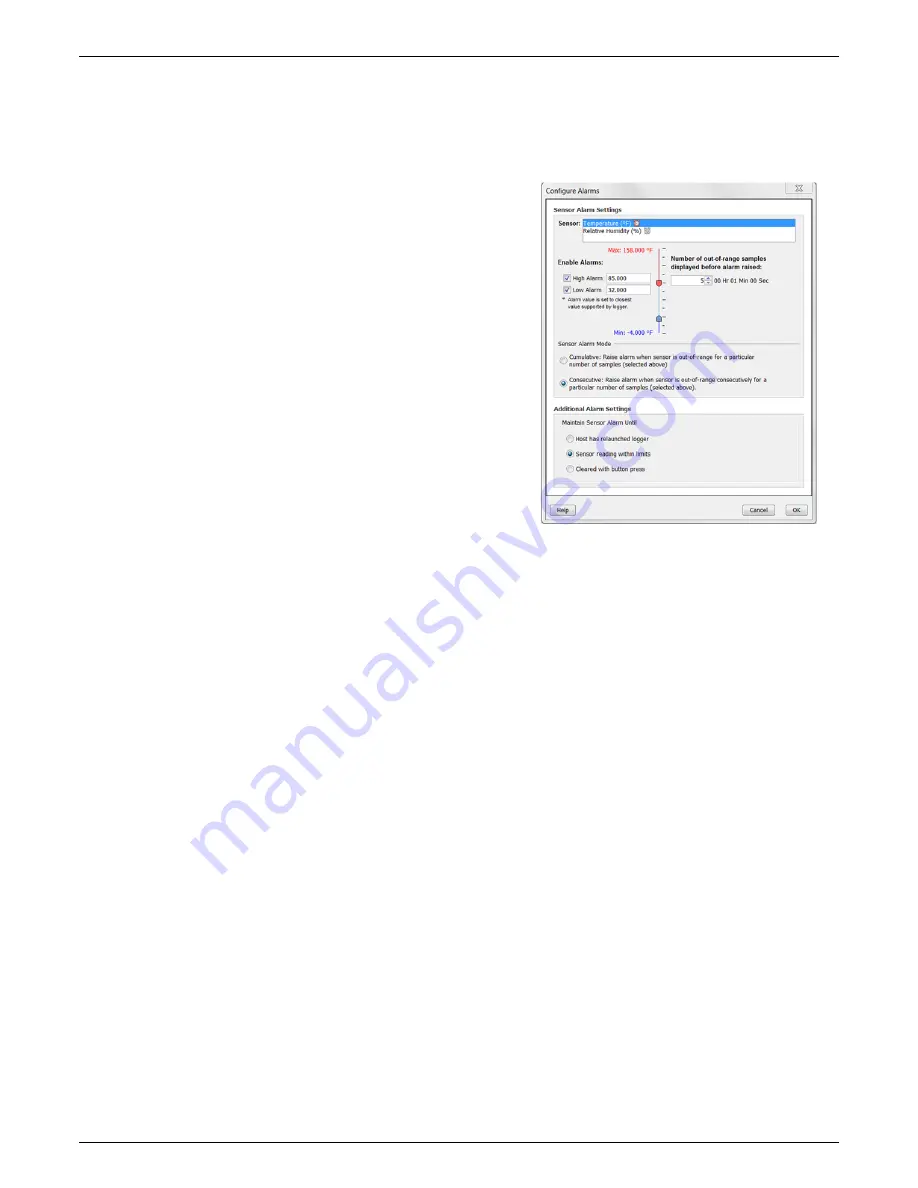
HOBO Temp/RH 3.5% Data Logger (UX100-003) Manual
1-800-LOGGERS 4
www.onsetcomp.com
•
Normal.
In Normal mode, data will always be recorded at
the regular logging interval set in the previous step. This
is the default setting.
•
Burst.
In Burst mode, logging will occur at a different
interval when a specified condition is met. See
Burst
Logging
for more information.
•
Statistics.
In Statistics mode, maximum, minimum,
average, and standard deviation statistics are calculated
for all enabled sensors during logging, sampling at an
interval you specify. See
Statistics
for more information.
7.
Choose when to start logging:
•
Now.
Logging begins immediately.
•
At Interval.
Logging will begin at the next even interval as
determined by the selected logging interval.
•
On Date/Time.
Logging will begin at a date and time you
specify.
•
Push Button.
Logging will begin once you press the
Start/Stop logging button for 3 seconds.
8.
Choose when to stop logging:
•
When Memory Fills.
Logging will end once the logger
memory is full.
•
Never (Wrapping).
The logger will continue recording
data indefinitely, with newest data overwriting the
oldest. This option is not available if Burst is selected for
the Logging Mode.
•
Push Button.
Logging will end once you press the
Start/Stop logging button for 3 seconds. If you select
Push Button, you also have the option to select “Resume
logging on next button push.” Select this if you want to
be able to start and stop logging at any time during the
deployment by pushing the Start/Stop button on the
logger. Note that if you also choose Push Button to start
logging, then you will not be able to stop logging until 30
seconds after logging begins.
•
Specific Stop Time.
Logging will end at a date and time
you specify. Note that if you also configure the logger for
a Push Button stop and to “Resume logging on next
button push,” then the logger will stop logging at the
date you select regardless of how many times you stop
and restart the logger with the Start/Stop button.
9.
Choose whether to keep the LCD on or off.
By default, the
LCD will always remain on while logging. If you select the
“Turn LCD off” checkbox, the LCD will not show the current
readings, status, or other information while the logger is
logging. You will, however, be able to temporarily turn the
LCD screen on by pressing the Start/Stop button for 1
second if you select this option.
10.
Click the Start button to launch the logger.
Disconnect the
logger from the computer and deploy it using the mounting
materials (see
Mounting the Logger
). After logging begins,
you can read out the logger at any time (see
Reading Out
the Logger
for details).
Setting up Alarms
You can set an alarm to trip on the logger when a sensor
reading rises above or falls below a specified value. To set an
alarm:
1.
Click the Alarms button from the Launch Logger window. If
the Alarms button is disabled, make sure the Logging Mode
is not set to Burst. (Alarms can only be configured if the
logger is in Normal or Statistics mode.)
2.
Select a sensor. In this example, the temperature sensor
was selected.
3.
Select the High Alarm checkbox if you want an alarm to trip
when the sensor reading rises above the high alarm value.
Type the reading next to the High Alarm checkbox or drag
the red upper slider in the Configure Alarms window.
4.
Select the Low Alarm checkbox if you want an alarm to trip
when the sensor reading falls below the low alarm value.
Type the reading next to the Low Alarm checkbox or drag
the blue lower slider.
5.
Set the “Number of out-of-range samples displayed before
alarm is raised,” which is the number of sensor readings
needed to trigger each alarm. The time next to the
“Number of out-of-range…” field indicates the amount of
time it will take for the alarm to trip based on the number
you entered in that field and the 15-second LCD refresh
rate.
6.
Select either Cumulative or Consecutive for the Sensor
Alarm Mode. If you select Cumulative, the alarm will trip
after a specific number of samples (as set in the previous
step) are outside the limits (the high or low samples do not
need to be consecutive). If you select Consecutive, the
alarm will trip after a specific number of samples (as set in
the previous step) outside the limits are displayed in a row.
7.
Repeat steps 2 through 6 for the other sensor if desired.
8.
Choose how long the logger should maintain a sensor alarm
once it has tripped. Select “Host has relaunched logger” if
you want the alarm to remain visible on the LCD until the
next time you relaunch the logger. Select “Sensor reading
within limits” if you want the alarm to clear once the sensor
reading returns to the normal range between the high and
low alarm limits. Select “Cleared with button press” if you
want the alarm to remain on until you press the Alarm/Stats
button on the logger.
9.
Click OK to save alarm settings.








